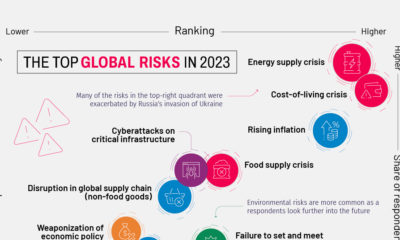The Fall of the Mighty Euro
The European Union has always been primarily a political project. The idea of the union was to take peoples that had long and complicated histories, and to place them in a situation where they must work together and shed their differences in order to achieve success. From the political angle, it can be argued that this objective has been achieved. War and conflict within Western and Central Europe has mostly been stymied. Considering the continent’s lengthy history in these areas, this is great news. However, it’s particularly the countries that adopted the euro as common currency that put themselves into a more precarious economic position. The problem is simple: countries maintain certain political and fiscal responsibilities, but do not control the fate of their common currency. The result is that eurozone politicians have very different fiscal policies, but don’t have the flexibility of monetary policy to help accompany them. Some countries are trying to spend their way out of trouble, while others are maintaining strict austerity. Either way, the European Central Bank (ECB) controls the plight of the currency and can make unilateral decisions that have a big impact on every country. For example, in the beginning of June 2015, the ECB announced the minimum of a $1.14 trillion quantitative easing program that will add new currency units that together are larger than the economies of Ireland, Greece, Portugal, Finland, Luxembourg, and Slovenia combined. There has been an array of other problems plaguing the eurozone as well. The most notable of these was that Greece was admitted into the monetary union in the first place after fudging numbers on the Greek economy. Even though Greece makes up about 2% of the overall eurozone, the country has been in constant trouble that has threatened to undermine the entire union. (For a primer on this, read The Origin of the Greek Crisis) The euro itself has dropped precipitously, particularly in terms of USD but also in terms of GBP and CNY. In the beginning of 2008, a US dollar could buy only €0.65 euros. Today, on average through 2015, one US dollar can buy €0.91 euros. With European demographics getting more challenging by the year, and deflation stalking the eurozone, problems don’t seem to be going away for the euro. The crises in Ukraine and Greece continue on without much resolved, and the ECB is continuing on with its QE program. Meanwhile, the Refugee Crisis has created another political distraction that has its own challenges for the people of Europe. Will the shrinking euro be able to revert its course, or is Europe doomed to become the next Japan? Original graphic by: Coupofy
on The good news is that the Federal Reserve, U.S. Treasury, and Federal Deposit Insurance Corporation are taking action to restore confidence and take the appropriate measures to help provide stability in the market. With this in mind, the above infographic from New York Life Investments looks at the factors that impact bonds, how different types of bonds have historically performed across market environments, and the current bond market volatility in a broader context.
Bond Market Returns
Bonds had a historic year in 2022, posting one of the worst returns ever recorded. As interest rates rose at the fastest pace in 40 years, it pushed bond prices lower due to their inverse relationship. In a rare year, bonds dropped 13%.
Source: FactSet, 01/02/2023.
Bond prices are only one part of a bond’s total return—the other looks at the income a bond provides. As interest rates have increased in the last year, it has driven higher bond yields in 2023.
Source: YCharts, 3/20/2023.
With this recent performance in mind, let’s look at some other key factors that impact the bond market.
Factors Impacting Bond Markets
Interest rates play a central role in bond market dynamics. This is because they affect a bond’s price. When rates are rising, existing bonds with lower rates are less valuable and prices decline. When rates are dropping, existing bonds with higher rates are more valuable and their prices rise. In March, the Federal Reserve raised rates 25 basis points to fall within the 4.75%-5.00% range, a level not seen since September 2007. Here are projections for where the federal funds rate is headed in 2023:
Federal Reserve Projection*: 5.1% Economist Projections**: 5.3%
*Based on median estimates in the March summary of quarterly economic projections.**Projections based on March 10-15 Bloomberg economist survey. Together, interest rates and the macroenvironment can have a positive or negative effect on bonds.
Positive
Here are three variables that may affect bond prices in a positive direction:
Lower Inflation: Reduces likelihood of interest rate hikes. Lower Interest Rates: When rates are falling, bond prices are typically higher. Recession: Can prompt a cut in interest rates, boosting bond prices.
Negative
On the other hand, here are variables that may negatively impact bond prices:
Higher Inflation: Can increase the likelihood of the Federal Reserve to raise interest rates. Rising Interest Rates: Interest rate hikes lead bond prices to fall. Weaker Fundamentals: When a bond’s credit risk gets worse, its price can drop. Credit risk indicates the chance of a default, the risk of a bond issuer not making interest payments within a given time period.
Bonds have been impacted by these negative factors since inflation started rising in March 2021.
Fixed Income Opportunities
Below, we show the types of bonds that have had the best performance during rising rates and recessions.
Source: Derek Horstmeyer, George Mason University 12/3/2022. As we can see, U.S. ultrashort bonds performed the best during rising rates. Mortgage bonds outperformed during recessions, averaging 11.4% returns, but with higher volatility. U.S. long-term bonds had 7.7% average returns, the best across all market conditions. In fact, they were also a close second during recessions. When rates are rising, ultrashort bonds allow investors to capture higher rates when they mature, often with lower historical volatility.
A Closer Look at Bond Market Volatility
While bond market volatility has jumped this year, current dislocations may provide investment opportunities. Bond dislocations allow investors to buy at lower prices, factoring in that the fundamental quality of the bond remains strong. With this in mind, here are two areas of the bond market that may provide opportunities for investors:
Investment-Grade Corporate Bonds: Higher credit quality makes them potentially less vulnerable to increasing interest rates. Intermediate Bonds (2-10 Years): Allow investors to lock in higher rates.
Both types of bonds focus on quality and capturing higher yields when faced with challenging market conditions.
Finding the Upside
Much of the volatility seen in the banking sector was due to banks buying bonds during the pandemic—or even earlier—at a time when interest rates were historically low. Since then, rates have climbed considerably. Should rates moderate or stop increasing, this may present better market conditions for bonds. In this way, today’s steep discount in bond markets may present an attractive opportunity for price appreciation. At the same time, investors can potentially lock in strong yields as inflation may subside in the coming years ahead. Learn more about bond investing strategies with New York Life Investments.


























